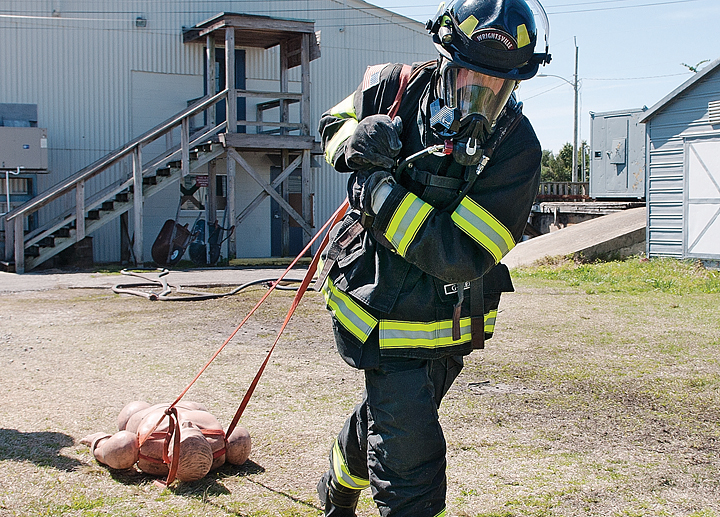Dragging heavy fire hoses up stairs, breaking through locked doors to reach trapped victims and carrying people to safety are a few of the tasks the Wrightsville Beach firefighters could face on the job. Saturday, March 21, the department put its crew members through a fitness course simulating each of those situations to ensure they are mentally and physically prepared.
Each firefighter, dressed in full gear, went through the course over and over until his or her self-contained breathing apparatus tank was depleted. Wrightsville Beach Fire Department Captain Robert Pugh said the air tanks can last anywhere from 20 to 55 minutes, depending largely on how hard the firefighter is breathing.
Pugh said the exercise helps determine more precisely the minimum time the air tanks last, which is critical.
“It tells us as a department, on average, what is our lowest time,” he said, “so if we send a crew in with their safety packs . . . [we know] in 15 minutes they should be coming out and we should be sending someone in to relieve them.”
Lead intern Garrett McQueen, who has completed the course each of the three years he has been with the department, said it is also important the firefighters know how to manage their own air supply.
“It helps you realize how much work you can do with a certain amount of air,” he said. “You don’t want to be in a fire and realize you’re really low on air, and you don’t have enough air to get out of the building.”
When the firefighters’ tanks are low, Pugh said, red lights flash in their masks. Department policy mandates they vacate the structure when that happens, because at that point they have seven to 10 minutes before their air supply is completely depleted.
Saturday’s test was set up in the department’s wooden training structure. The firefighters first carried a 40-pound hose up two flights of stairs, a situation McQueen said they would encounter frequently in Wrightsville Beach.
“Most of the houses on Wrightsville Beach, they’re all elevated a level because of the stilts they’re on,” McQueen said.
They dropped the first hose and reached out a nearby window to pull a second 40-pound coiled hose up toward them, which McQueen said mimics another way of raising tools or air tanks to the second floor of a building.
Next, each firefighter practiced swinging a sledgehammer.
“That simulates any kind of forceful entry that you might have to do with a sledgehammer or an ax,” Pugh said, “. . . cutting a hole in a roof to ventilate hot gasses, forcing entry into a place to get somebody, things of that nature.”
Then, they dragged a charged hose 100 feet, used the jet of water to knock over a cone and lifted a 12-foot bar over their head 15 times. The final exercise of the course involved dragging a 150-pound dummy 100 feet away from the house.
The firefighters kept circulating the course until their air tanks were depleted. To pass the test, they had to run through the course at least twice, McQueen said, but he and several other firefighters completed as many as seven laps.
While many of the firefighters strive to keep themselves physically fit to complete as many laps as possible, Pugh said speed is not the goal.
“We don’t want them to go slow,” he said, “but we don’t want them to run either. … Not only in this exercise, but on the fire ground, guys are getting more work in if they’re working with purpose instead of rushing.”
The main purpose of the exercise, McQueen said, is for each firefighter to learn how far to safely push his or her body in high stress situations.
“When you’re on the fire ground and you feel really tired … you can remember that you can actually do more than you think you can,” he said, “and that could possibly help save a life.”
email [email protected]




